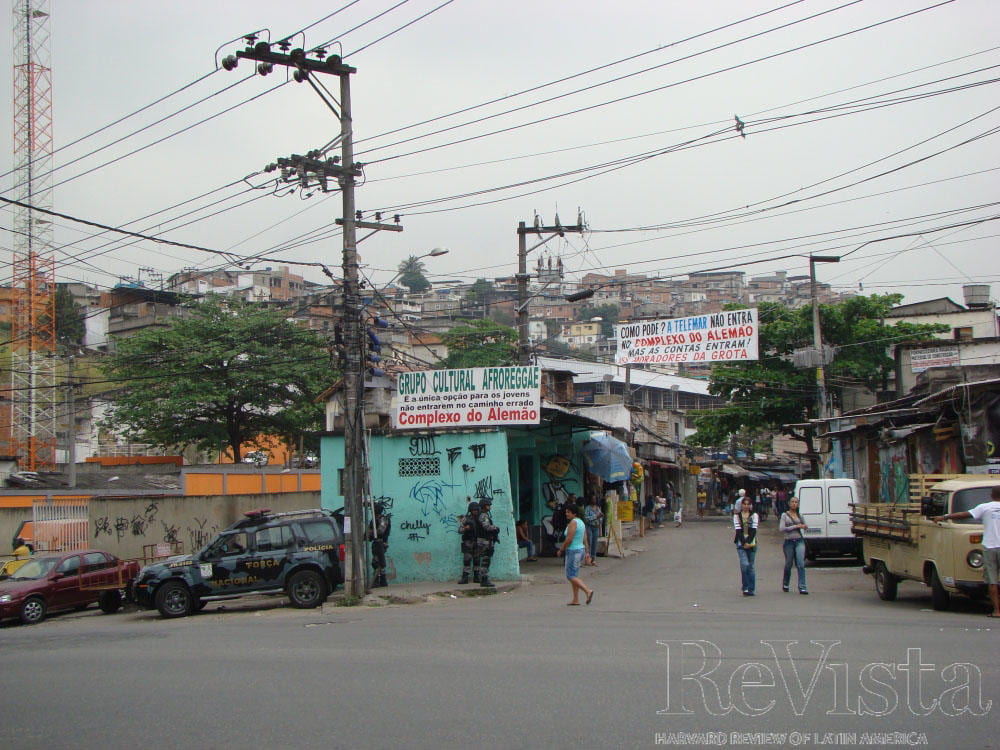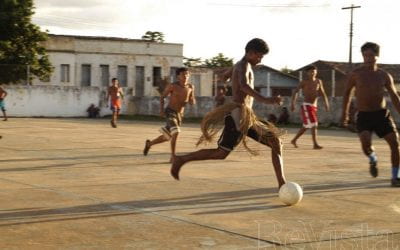What have we Brazilians been doing to break the on-going cycle of violence plaguing the country over the past three decades? Can we offer a safe environment to foreign visitors before we host the World Cup in two years? And in the Olympic Games in 2016? You may have seen some of the violent scenes on the streets of Rio de Janeiro or in the northeast: helicopters shot down by heavily-armed drug traffickers, gunfights in luxury hotel lobbies, mass murders and judges assassinated by police officers. This looks like an environment of urban warfare.
A visit to one of the areas controlled by gangs involved in drug trafficking is an eye-opening experience, with younger boys and girls serving as lookouts to alert gang members about the possible intrusion of enemies and/or police. At the same time, on the broader, surrounding streets of the favela, another set of armed boys and girls keep watch from wooden benches or crates—also equipped with handheld radio communicators. Drug transactions openly take place with other boys and girls delivering large plastic bags—all the while in contact with the armed lookouts. The entire favela has taken on the look of actual military operations. All of this translates into an ever-present sense of insecurity for the people living in large urban centers.
However, the boys and girls on the lookout are only tangential protagonists of the organized crime threatening the order and power of the Rio de Janeiro state. Those who have kept a trained eye on the situation have discerned a worrisome rising criminal profile with very distinct traits and an even more organized design. Criminal activity has been structured with the logic of large urban centers. Crime begins with gang activity in impoverished neighborhoods with high unemployment and unfavorable economic and social conditions. Jailing gang members has led to a new level of organization initially developed within prison walls in the form of coalitions that serve originally for protection but rapidly degenerate into criminal activity. The main Brazilian criminal factions today originated in the slums and organized in jail. Groups compete intensely, using both and increasing mechanisms of corruption to win fierce competition for territory.
As the situation seems to evolve from laissez-faire gangs to organized crime, is it possible to turn things around before the World Cup and the Olympics? What is being done – and what are the results that are being registered in major cities around the country? A few states, such as São Paulo and Minas Gerais, have managed to achieve important milestones, while other states like Bahia and Alagoas have witnessed a dramatic decline in public safety conditions. Large to medium-size urban centers around the country have all suffered urban violence. Rio de Janeiro has used police occupation operations in extremely violent areas to re-establish order in the communities bordering tourist attractions, and such strategies may be implemented in other parts of the city over the short-term.
But is this enough to ensure public safety and improve the institutions in charge of security? Let’s take a moment to recall some of the specific characteristics of crime in Brazil. First, crime does not occur in the same way and to the same degree throughout the entire country. In some regions, highly organized groups tightly control the areas they dominate. In a large portion of more populated urban centers, youth gangs fight each other in poorer, underprivileged areas. But now, they are being replaced by more organized groups that have a different logic, more structured and rational.
All violence—independently of its level of organization—is usually spatially concentrated and tends to contaminate surrounding areas and neighboring communities. Violent communities continue to perpetuate the crime pattern that has been present over many years and open the doors to organized crime as fertile grounds for recruiting and sales.
It is known that concentrated socio-economic disadvantages are inseparable from the presence and ills of concentrated violence. On the other hand, not all underprivileged areas have elevated violence. Many neighborhoods, communities andfavelas are relatively peaceful; conversely, we have yet to find a violent area that is not classified as underprivileged. However, organized crime—often originating in poor communities—manifests itself in wealthier communities through public insecurity, money laundering, corruption and extortion.
One of the most emblematic scenes for Brazil in the fight against crime in underprivileged communities was the occupation of the Vila Cruzeiro neighborhood by Rio de Janeiro’s police force. After a number of successive criminal attacks against the population, the police stormed and overtook two of the main strongholds. It was the beginning of the attack on “the heart of evil,” as the state’s public safety chief termed it. Television viewers saw amazing images of a horde of Vila Cruzeiro drug traffickers scrambling from police into the neighboring Complexo do Alemão—the next area to be raided and taken by the Army and police. Viewers saw a crew of rag-tag young men that did not seem to fit the image of organized crime thought to rule over Rio de Janeiro’s favelas. Rather than looking like an irresistible fortress, the scene suggested more a symbolic decline of an era of organized crime if it was represented by that particular group of young men. At any rate, the state’s simple territorial occupation of the community was an important moment in the area’s public safety policy.
Lately, iron-fisted governmental strategies have been pushing out traditional criminals. Instead, they stimulated the growth of, and competition between, organized crime groups that tend to take a business approach and have more efficient criminal patterns. The aim of these groups has increasingly turned toward making political connections, sometimes getting representatives from the groups elected into office in legislative assemblies and on municipal boards.
As a result, “militias” are developing within Rio de Janeiro’s criminal scene. Police and military officer involvement with these illegally formed groups within favelas has long been said to be common. However, over the last few years, we have seen these militias become stronger, reorganizing their activities on an entirely new level. Because the state is not capable of restoring order in these communities, criminal activities take on an informal, however no less illegal, shape through militia groups. The key factor to minimize the conflict between groups tends to be through radical methods of controlling the market—which, in turn, includes the imprisonment of, or even elimination of competitors. In addition, commercial activities have begun to branch out into other areas beyond those of drug trafficking, again no less illegal, in the form of informal access to public services, illegal connection to the electric power system, goods and services such as gas, transportation and public safety and even prostitution rings. Because conflict is costly and time-consuming, cooperation among groups and reaching an understanding with police offers a better alternative to warring with local factions. As groups have developed a sharper business sense through the expansion of mechanisms of control and monopoly of local markets, excessive violence is seen as less necessary.
Both social and institutional factors perpetuate this situation. Communities made up of families lacking structure, wracked by teenage pregnancy, truancy, poor schooling and informal employment, in addition to high rates of alcoholism and drug-addiction, provide fertile grounds for producing a generation of youths with little to no supervision, and whose family members have limited control over their behavior.
However, the leap from the conditions that breed crime to new, organized criminal levels has more to do with the institutional incapacity to deal with more complex criminal structures. The modernization of the criminal justice system, focusing on particularly intense police reform, is one of the most important priorities.
The ability to establish control and cohesion mechanisms in communities riddled with violence—known in the literature as collective efficiency—in truth depends heavily on the strength of institutions. One of the most important aspects in the control of crime pivotally depends on the active participation of the Brazilian criminal justice system.
Brazilian court proceedings are slow, resulting in incredibly low conviction rates. Fewer than one of ten homicides result in some sort of punishment; only 23% of cases reaching the courts are ruled on by judges. We have penal laws created in the 1940s for a completely different scenario than the one currently being faced.
Our police force is poorly managed; it is frequently lax in carrying out essential duties and, to bring back a recurring theme, often involved in serious cases of human rights violations, police abuse and brutality. Some states have seen record highs in victim fatality in police actions. Over the last ten years, the Rio de Janeiro police force has been responsible for more than 11,000 violent deaths—a figure that accounts for 20% of overall homicides in the same city. Corruption levels and police involvement in organized crime have reached fever pitch.
How has this come about? A succession of poorly run governments have lacked the political mettle required to take on serious public safety issues and to allocate the necessary financial resources and institutional re-engineering. If we add to the equation the constantly acute situation of the favelas and housing issues in Brazil, the processes of spatial segregation and socio-economic decay in the population of large urban centers, informality, disorder and disorganization, we have a recipe for the same disasters we have witnessed in other Latin American countries. Lethargic and inefficient justice departments prevail, while government administrations fail to introduce incremental mechanisms of effective management, as well as the appropriate legislative infrastructure.
Nevertheless, it is also a fact that many states in Brazil have shown exceptional results in the fight against crime. Over the past 20 years, the relative absence of the federal government in addressing public safety issues has forced governors to take matters into their own hands in the search for effective solutions.
With its declining homicide rate, São Paulo is an intriguing case study to analyze. The city has attempted to restructure investigative precincts by increasing staff and providing training. In addition, police officers on the street have focused on confiscating weapons wherever and whenever possible. Coupled with a proper, modernized information system and high arrest rates, the effort has resulted in a direct decrease in crime indicators. Similar investment in modern police management methods, decentralization and integration of the public safety sector taken by the state of Minas Gerais has now led to a 50% reduction in violent crimes in its large urban centers.
The enormous events that Brazil will host have also served as a catalyst for solutions that may come together to provide positive results in public safety. Even if the initial purpose may be to construct pockets of safety for visitors of these events, they may result in creating ever-expanding safe havens that may one day end up as an entire continent of safety.





